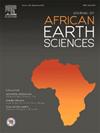在尼日利亚西南部Ilesha片岩带部分地区实施机器学习预测模型,用于定位金矿远景图
IF 2.2
4区 地球科学
Q2 GEOSCIENCES, MULTIDISCIPLINARY
引用次数: 0
摘要
本研究利用创新的机器学习技术,包括人工神经网络(ANN)、支持向量机(SVM)、随机森林(RF)和Naïve贝叶斯(NB),构建了Ilesha部分片岩带金矿预测模型。从地球物理、遥感和地质数据集中使用了13个预测图,突出了成矿的基本过程,如来源特征、运输机制和化学沉积。这些数据集与35个金矿和非金矿地点一起,使用10倍交叉验证技术来训练和测试机器学习模型。使用混淆矩阵、统计指标和受试者工作特征(ROC)曲线评估疗效。所有模型都取得了较高的预测准确率:RF为98.94%,ANN为97.80%,SVM为93.65%,NB为90.48%。关键的定位因素包括磁性线密度、结构复杂性、SRTM线密度、分析信号和布格重力异常。利用训练好的模型,绘制了远景图,突出显示了非常高、高、中等和低潜力的区域,供进一步研究。所有模型的预测面积均超过78%,证实了模型在该区识别重要金矿床的有效性。欧拉反褶积表明,磁源深度为<;-12.96 m至>;- 801.67米,距离<;−30.82 m至>;-1053.94m,构造指数(SI)分别为0.5和1,光谱分析表明浅层源深度为100m ~ 1.1 km。300 m以下,特别是Iwaraja/Ifewara断裂及岩性边界附近的磁源与金矿远景具有很强的相关性。这项研究强调了机器学习模型在黄金勘探中的有效性,并为未来类似地质背景下的研究提供了途径。本文章由计算机程序翻译,如有差异,请以英文原文为准。
Implementation of machine learning predictive models for targeting gold prospectivity mapping in part of the Ilesha schist belt, southwestern Nigeria
This research leverages innovative machine learning techniques, including artificial neural networks(ANN), support vector machines(SVM), random forests(RF), and Naïve Bayes(NB), to construct a predictive model for gold deposits in part of the Ilesha schist belt. Thirteen predictor maps were used from geophysical, remote sensing, and geological datasets highlighting essential processes in ore formation, such as source characteristics, transport mechanisms, and chemical deposition. Together with 35 gold deposits and non-deposit locations, these datasets were employed to train and test the machine learning models using 10-fold cross-validation techniques. Performance was evaluated with confusion matrices, statistical metrics, and receiver operating characteristic (ROC) curves. All models achieved high predictive accuracy: RF at 98.94%, ANN at 97.80%, SVM at 93.65%, and NB at 90.48%. Key localization factors include magnetic lineament density, structural complexity, SRTM lineament density, analytical signals, and Bouguer gravity anomalies. Using the trained models, prospectivity maps were created, highlighting areas of very-high, high, moderate, and low potential for further research. The Prediction-Area for all the models exceeded 78%, confirming their effectiveness in identifying significant gold deposits in the area. Euler deconvolution suggests geological influences from sill/dyke structures, with magnetic source depths from <-12.96 m to > - 801.67 m and from < −30.82 m to > -1053.94m for structural indices (SI) of 0.5 and 1, respectively while spectral analysis indicates depths of 100m to 1.1 km for shallow sources. A strong correlation exists between gold prospectivity and magnetic sources below 300 m, especially near the Iwaraja/Ifewara fault and lithological boundaries. This study highlights the effectiveness of machine learning models in gold exploration and suggests avenues for future research in similar geological contexts.
求助全文
通过发布文献求助,成功后即可免费获取论文全文。
去求助
来源期刊

Journal of African Earth Sciences
地学-地球科学综合
CiteScore
4.70
自引率
4.30%
发文量
240
审稿时长
12 months
期刊介绍:
The Journal of African Earth Sciences sees itself as the prime geological journal for all aspects of the Earth Sciences about the African plate. Papers dealing with peripheral areas are welcome if they demonstrate a tight link with Africa.
The Journal publishes high quality, peer-reviewed scientific papers. It is devoted primarily to research papers but short communications relating to new developments of broad interest, reviews and book reviews will also be considered. Papers must have international appeal and should present work of more regional than local significance and dealing with well identified and justified scientific questions. Specialised technical papers, analytical or exploration reports must be avoided. Papers on applied geology should preferably be linked to such core disciplines and must be addressed to a more general geoscientific audience.
 求助内容:
求助内容: 应助结果提醒方式:
应助结果提醒方式:


